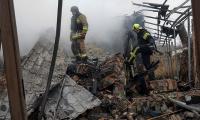KARACHI: As Sindh continues to reel under the deluge, the Flood Forecast Division reported high flood in the Guddu-Sukkur stretch and medium flood at Kotri on Saturday. This came as the rapidly rising water level in Manchhar Lake threatened Jamshoro and Dadu districts, especially Juhi town. The administrative machinery was geared up for taking precautionary measures in case of an emergent situation, including evacuation of the population in vulnerable areas.
Also, according to NDMA, 26 more people died in the continuing floods across the country, taking the death toll since mid-June to 1,290. On Friday, it said 57 people had died. In what could be another serious problem, the water level in Manchhar Lake is rapidly rising in Jamshoro and Dadu districts, according to a report. The water level of the lake has presently reached 122.5 RL, irrigation department has warned. During his visit to Manchhar Lake, the largest natural freshwater lake in Pakistan, Sindh Chief Minister Murad Ali Shah on Friday said that the water level in the lake will be dangerous if it reaches the level of 123 feet. The water from Main Nara Valley, MNV Drain and flood water around Juhi is entering into the Manchhar Lake, which is swelling with water of flash floods in the Kirthar Range and flooding in the Indus River. Deputy Commissioner, Jamshoro, said that precautionary measures are being taken owing to a rapid surge in the water level of Manchhar Lake. Population settlements could be evacuated in case of a further increase in the water level of the lake, he added.
The situation is said to be critical at Bubak Band RD 62 of Manchhar Lake. Floodwater is overtopping the Danister Canal owing to pressure at RD 62. It is being apprehended that the gate of Danister Canal could be broken under the pressure of the floodwater, relief officials said. The Manchhar Lake is directly in the south of Hamal Lake and the two are connected by the Main Nara Valley Drain.
In the Dadu district of Sindh, several villages are already under as much as 11 feet (3.35m) of water. In neighbouring Mehar, residents were constructing a dyke in an attempt to prevent floodwaters from entering the town.
Meanwhile, the navy airlifted more than 150 people from villages in Dadu on Thursday, it said in a statement.
According to NDMA, across the country, 26 more people died in the continuing floods taking the death toll from mid-June to 1,290. In a province-wide breakup, 22 died in Sindh, two in Punjab and two more in Balochistan.
Road communication could not be fully restored in Khyber Pakhtunkhwa. In Swat, people continue to suffer as the road from Kalam to Bahrain remains closed to traffic. People have run out of daily commodities and are suffering from complex problems. The picturesque town was battered by this season’s rains and floods. . The floods also damaged the Mohmand Dam head works. In absence of roads and bridges people of the area are forced to use makeshift boats and rafts to reach safer higher ground. The floods torrents reduced Malikabad in Nowshera to foot-high muck and mud causing serious problems for the women and the rest of the population. The same is the story with hundreds of dozens of villages across the country.
Following the outbreak of various diseases in Khyber Pakhtunkhwa and Sindh, infectious diseases have also surfaced in the flood-affected areas of Punjab and Balochistan. The Punjab Health Department has released the data on infectious diseases among the flood affectees, according to which, the highest number of diseases have been reported in Southern Punjab. The data showed that over 140,000 flood victims are suffering from different diseases, out of which more than 37,000 people are suffering from respiratory diseases.
It has been reported by the Punjab Health Department that over 33,000 people are suffering from itching and rash diseases while more than 17,000 victims from Southern Punjab are infected with various stomach diseases including diarrhoea. The floods have let in their wake many tragic tales of human losses and sufferings. The calamity fell on an 80-year-old in Rahim Yar Khan in south Punjab. The old lady and her granddaughter are waiting for the rest of the family, on Khalifa Bridge, whom they lost when the flood torrents hit and destroyed their house, sweeping away livestock, and crops.
As many as 81,940 cases of diarrhoea have been reported from 26 districts of Balochistan, according to the provincial health authorities. Districts of Kech, Khuzdar, Lasbela, Jaffarabad, Jhal Magsi, Pangur, Sohbatpur and Killa Saifullah are among the severely hit. In the aftermath of the epochal floods, the plight being witnessed across Balochistan particularly, the suburbs of provincial capital Quetta, is no different from the rest of the country. In one of the least developed regions of the country, 63,000 houses were damaged or destroyed.
Power was made available to Quetta only on Friday after the 132 KV transmission line was restored.
The FFD forecast scattered thunderstorms/rain of moderate intensity with one or two heavy falls over the upper catchments of all the major rivers. According to the daily Federal Flood Commission report, at present, River Indus was flowing in high flood in Guddu-Sukkur Reaches and in medium flood at Kotri.
Meanwhile, briefing the media persons at National Flood Response and Coordination Center Major General Babar Iftikhar, Director General of Inter-Services Public Relations (ISPR) said the confidence of the people in the Armed Forces was their asset and they would overcome the record flood calamity with the nation’s cooperation.
He was addressing the media alongside Minister for Planning Ahsan Iqbal and Chairman NDMA. Major General Babar Iftikhar said in every natural calamity and extraordinary situation, the Armed Forces have been at the forefront to help out the nation. “ Keeping up with their traditions, we will bring to use every resource and effort in the flood-affected areas of the country,” the ISPR DG in a media brief said. He maintained that in line with the directives of the Chief of Army Staff (COAS), they would not leave people alone in their time of hardship and misery irrespective of the extent of efforts required for their relief and rehabilitation. The DG ISPR said the COAS Gen Qamar Javed Bajwa was in contact with international friends for assistance in the flood relief effort.
Major General Babar Iftikhar pointed out that Corps Commanders’ Conferences which were held during the months of July and August also affirmed their commitment to assist the flood-affected people in every possible way and the Army Chief also issued necessary directives. He maintained that every officer and sepoy of the Pakistan Army is active to help out the flood-affected people while considering it a sacred mission more than a duty. It was during the performance of this mission of flood relief operation that Lt. General Sarfraz Ali, Major General Amjad Hanif, Brig. Muhammad Khalid, Major Saeed Ahmad, Major Muhammad Talha Manan and Naek Mudassar Fayyaz were martyred in a helicopter crash, he recalled.
He said that Armed Forces have been active in flood-hit areas for the last two months while utilizing all of their resources. All the formations and senior command of the Pakistan Army are present and taking part in flood relief, rescue and rehabilitation activities in affected areas, Maj Gen Iftikhar said. The COAS also visited calamity-hit areas in Balochistan, Sindh, Khyber Pakhtunkhwa and Punjab and reviewed the ongoing relief operations on the ground. All the formations and senior commanders of the Pakistan Army were present in the flood-affected areas and were engaged in relief operations, he added. He said the army has set up an Army Flood Relief Coordination Center headed by Commander Army Air Defence who was also performing the duties of National Coordinator of National Flood Response and Coordination Centre. He said under the RRR Strategy i.e.Relief, Rescue & Rehabilitation, Pakistan Army is serving under a comprehensive strategy along with Civil Administration, Disaster Management Authority and other welfare institutions. The helicopters of Pakistan Army Aviation are also busy in relief and rescue operations in these areas and undertook 276 sorties and pilots not only rescued stranded people while endangering their lives but also dispatched relief goods to affected people. “ They also saved lives of people trapped in Kumrat and Kalam,” he said adding Pakistan Army has also established helpline 1125 for KP Province and 1135 for other provinces.
He informed that Pakistan Army so far had provided relief to 50,000 people at the army’s 147 relief camps besides providing medical treatment to 83,000 people at 250 medical camps. The DG ISPR said that so far Pakistan Army has distributed three days ration which includes 1,685 tons of food, and 25,000 packs of ready-to-eat meal. In total 2,294 tons of ration, 311 tons of other commodities and over one million medicines have been collected in 284 relief collection camps. So far 1,793 tons of ration and 277 tons of other commodities have been distributed. Apart from this, additional army medical and engineering resources have also been sent to Sindh.
Moreover, Pakistan Navy and Pakistan Air Force have also been taking an active part in rescue and relief activities. The C-130 aircraft and helicopters of PAF in 135 sorties rescued 1,521 people while ration and medicines were distributed at 41 relief camps. Around 16,000 people were provided free medical treatment at 35 medical camps. He said that Pakistan Navy’s emergency response and diving teams are similarly active in different areas and rescued over 10,000 stranded people in the affected areas. So far 55,000 food packets and 650 tons of ration were provided while 18,000 people were given free medical treatment.
The ISPR DG General Officers of Pakistan Army have donated their one-month salary to the Army Relief Fund while other officers and jawans were also making generous donations. So far, this fund has received Rs 417 million including Rs 44 million collected in the last 24 hours. He said that leadership of friendly countries was also in touch with Army Chief so that immediate relief measures could be taken for flood-hit areas. Maj Gen Iftikhar said that Pakistan Army also decided to cancel all the major ceremonies in connection with Defence Day falling on September 06 to express solidarity with flood victims. He mentioned that the people were not only enjoying freedom due to the sacrifices of martyrs but an atmosphere of peace was there due to their sacrifices.“ During this month of September, we salute sacrifices of all Shuhdaa and Ghazis and their families,” he said.
Speaking on the occasion, Minister for Planning Ahsan Iqbal pledged to bring back “normalcy” and provide relief to the affected people after deadly floods killed more than 1,200 and destroyed millions of homes. He assured the nation that the government — supported by its government functionaries — would leave “no stone unturned” to bring normalcy back at the earliest possible time. The planning minister also called on the international community to ensure that their resolve for support to Pakistan remains undeterred as the scale of the disaster warrants a major humanitarian response.
Five thousand KG of hashish, heroin, bhang and ice worth Rs2,634.44 million were destroyed
Programme approved during recent UAE government annual meetings under directives of Emirates Genome Council
Atta Tarar congratulated Pakistan team on winning ODI series against South Africa
PIA spox says national airline is working to rejuvenate its aircraft, bringing them back into operational fleet
Authorities confirm driver’s death, saying he “committed suicide while the train was moving”
Murad stresses need to protect country from external conspiracies, in line with Jinnah’s vision







